Anatidae • Cathartidae • Accipitridae • Falconidae • Phasianidae • Rallidae • Gruidae
This list contains pictures of birds found on the official Louisiana Checklist. These birds were photographed within the state except where noted. Birds marked with an asterisk (*) are currently on the review list of the Louisiana Bird Records Committee.
ORDER ANSERIFORMES
Family Anatidae: Swans, Geese and Ducks
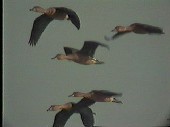
|
Fulvous Whistling-Duck |
| |
Black-Bellied Whistling-Duck |
| |
Tundra Swan* |
| |
Trumpeter Swan (Q)* |
| |
Greater White-Fronted Goose |
| |
Snow Goose |
| |
Ross' Goose |
| |
Brant* |
| |
Canada Goose |
| |
Wood Duck |
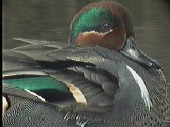
|
Green-Winged Teal |
| |
American Black Duck |
| |
Mottled Duck |
| |
Mallard |
| |
Northern Pintail |
| |
Blue-Winged Teal |
| |
Cinnamon Teal |
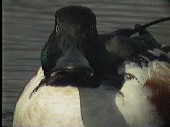
|
Northern Shoveler |
| |
Gadwall |
| |
Eurasian Wigeon* |
| |
American Wigeon |
| |
Canvasback |
| |
Redhead |
| |
Ring-Necked Duck |
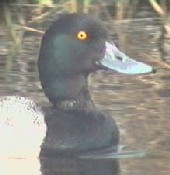 Adult Male Closeup
Head Viewed From Directly In Front
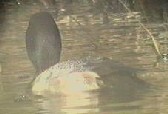 Head Viewed From Directly Behind
|
Greater Scaup
Greater Scaups are greatly outnumbered by Lessers in Louisiana, but in any large flock of Lessers, a Greater or two can often be found.
Overall Size: The larger size of Greater Scaups are usually good indicators of their presence in a flock of Lessers, although size within each species is variable. As hens are generally smaller than drakes, a female scaup larger than nearby drake Lesser Scaups is a good candidate for Greater.
Size and Shape of Head and Neck: The size difference also translates into different overall proportions. Greater Scaups have thick, long necks, with much wider sides of the head than Lessers. Seen from directly behind or in front (see comparative photos below), the heads of Lessers seem "pinched-in" along the eyelines. From the same angles, the heads of Greaters seem much less diminutive, and seem to bulge along the eyelines. In profile at rest, the crowns of Greaters are also rounder, compared to the more sculpted, peaked shape of Lessers. Another way of thinking of the difference in head shape is that the heads of Greaters are shaped like those of Redheads, while Lessers' heads are shaped more likeRing-necked Ducks. The difference in proportions is the best means of separating these two species.
Head Color in Males: The difference in the colors of the iridescence on the heads of male scaup is often dismissed as being too variable, but certainly when seen in direct comparison from similar angles the color provides a good clue. Lessers do show a green sheen at times, but in good lighting a purple gloss is usually apparent. Greaters in good light show a strong green sheen.
Size, Shape and Pattern of Bills: Greaters have a much stouter bill, deeper and wider at the base than the bills of Lessers. The shape of the nail also differs between species; in Greater, the nail is much wider. On Greater, the black of the nail often spreads out along the front edge of the bill, making the dark nail area visible at great range. Noted birder Laurie Binford believes that the greater area of black around the nail is a valid fieldmark for Greater Scaup.
Wing Pattern: The whitish flash running down the bases of the flight feathers generally extends down to the outer primaries in Greaters, and stops on the inner primaries in Lessers. However, there is often a hint of the Greater's pattern in many Lessers, though usually in a more subdued gray from the middle to the outer primaries. |
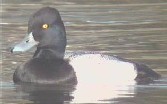
Adult Male Portrait |
Lesser Scaup
Lesser Scaup are abundant winterers in Louisiana, often seen by the tens of thousands offshore, and found in good numbers in deeper ponds inland as well. |
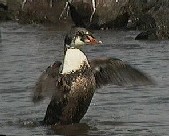
|
King Elder* |
| |
Oldsquaw |
| |
Black Scoter |
| |
Surf Scoter |
| |
White-Winged Scoter* |
| |
Common Goldeneye |
| |
Bufflehead |
| |
Hooded Merganser |
| |
Common Merganser* |
| |
Red-Breasted Merganser |
| |
Ruddy Duck |
ORDER FALCONIFORMES
Family Cathartidae: American vultures
| |
Black Vulture |
| |
Turkey Vulture |
Family Accipitridae: Kites, Eagles, Hawks and Allies
| |
Osprev |
| |
Swallow-Tailed Kite |

|
White-Tailed Kite |
| |
Mississippi Kite |
| |
Bald Eagle |
| |
Northern Harrier |
| |
Sharp-Shinned Hawk |
| |
Cooper's Hawk |
| |
Northern Goshawk* |
| |
Red-Shouldered Hawk |
| |
Broad-Winged Hawk |
| |
Swainson's Hawk |

|
White-Tailed Hawk*
The White-tailed Hawk is of casual occurence only in Louisiana, having been reliably recorded from the state only 4 times: Nov. 18, 1888, Calcasieu Parish. (imm., specimen); Jan. 19, 1972, Bastrop, Morehouse Parish, (sight record only); Dec. 1995-Jan.? 1996 (subadult, documented with photos, etc.), and Dec. 1996 (the individual portrayed here - almost certainly the same bird as the previous winter), adult bird, near a landfill near Welsh, Jeff Davis Parish. These individuals presumably wandered to the state from Texas, the nearest point in their breeding range to Louisiana. Before the destruction of the vast coastal prairies of Louisiana, this species' breeding range might conceivably have included the southwestern part of this state. |
| |
Harris' Hawk |
| |
Zone-Tailed Hawk* |
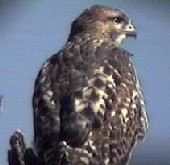
|
Red-Tailed Hawk |
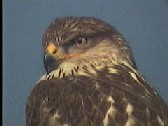
|
Ferruginous Hawk* |
| |
Rough-Legged Hawk* |
Family Falconidae: Caracaras and Falcons
| |
Crested Caracara* |
| |
American Kestrel |
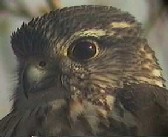
|
Merlin |

|
Peregrine Falcon |
ORDER GALLIFORMES
Family Phasianidae: Grouse, Turkeys and Quail
| |
Greater Prairie-Chicken (Q)* |
| |
Wild Turkey |
| |
Northern Bobwhite |
ORDER GRUIFORMES
Family Rallidae: Rails, Gallinules, and Coots
| |
Yellow Rail |
| |
Black Rail* |
| |
Clapper Rail |
| |
King Rail |
| |
Virginia Rail |
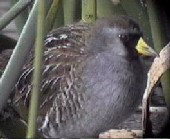
|
Sora |
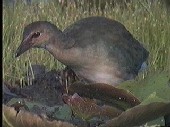
|
Purple Gallinule |
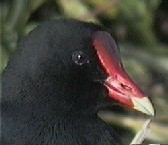
|
Common Moorhen |
| |
American Coot |
Family Gruidae: Cranes
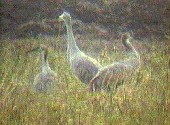
|
Sandhill Crane |
| |
Whooping Crane (Q)* |